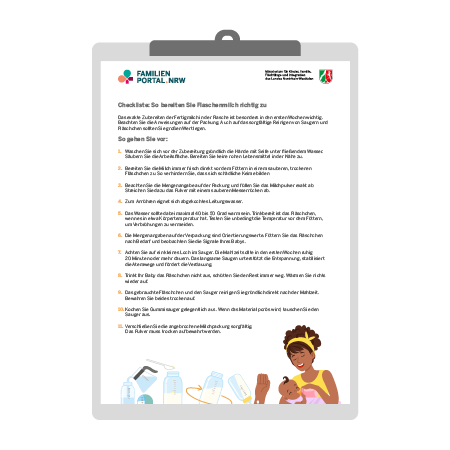If you are not breastfeeding
If they do not breastfeed their baby
Breast milk is the best food for the baby. But some moms can't (fully) breastfeed or don't want to. That's okay! What matters most is that your baby and you are doing well. Specially made infant formula is a good substitute. High-quality formula milk is as close as possible to the composition of breast milk and contains all the nutrients your baby needs. And you can also be very close to your baby when giving bottles - and take turns with the father, your partner or your partner at any time. At the same time, this strengthens the father-child relationship from the very beginning.

Which food is right for my baby?
- The very first food for newborns is an infant formula. You can tell by the word "Pre" in the name of the formula milk. It most closely resembles breast milk and contains only lactose as sugar. Your baby can drink as much of it as he or she wants. Feed the formula exclusively at least until the beginning of the 5th month if you are not breastfeeding. Your baby does not need any other milk or water or juices in addition during this period.
- 1er food is also suitable for the entire 1st year of life. It is usually used when the mother weans after a few weeks or months. In addition to lactose, the milk powder contains starch as other carbohydrates. This saturates longer and is more creamy.
- 2er- and 3er-following feed you at the earliest with the start of complementary feeding. Mandatory is the switch to the follow-on milk, however, not. Just as well you can continue to feed pre-food until the baby gets porridge.
- Please do not give your baby cow's milk! It contains much more protein and other minerals, unlike infant formula. This can not yet process the kidneys of your newborn.
- If you are unsure which food at what age is right for your baby, talk gladly with your midwife or with your pediatrician
How to properly prepare bottled milk
The exact preparation of the ready milk in the bottle is especially important in the first weeks. Follow the instructions on the package. You should also attach great importance to the careful cleaning of teats and bottles.
.-
Hygiene
Wash hands thoroughly with soap under running water before preparation. Clean the work surface. Do not prepare raw food in the vicinity.
-
Fresh preparation
Always prepare the milk fresh directly before feeding in a clean, dry bottle. This will prevent harmful germs from forming.
-
Portioning
Follow the quantity instructions on the package and fill the milk powder exactly. To do this, spread the powder with the back of a clean knife.
-
Stir
Boiled tap water is suitable for mixing.
-
Correct temperature
The water should not be warmer than 40 to 50 degrees. The bottle is ready to drink when it is about body temperature. Be sure to test the temperature before feeding to avoid scalding.
-
Feed as needed
The quantities on the packaging are orientation values. Feed the bottle as needed and observe your baby's signals.
-
Slow suction
Look for a small hole in the teat. The meal should calmly last 20 minutes or more in the first weeks. The slow sucking supports relaxation, stabilizes the airways and promotes digestion.
-
No storage
If your baby does not finish the bottle, always pour away the rest. Do not reheat anything.
-
Thorough cleaning
Clean the used bottle and teat thoroughly immediately after the meal. Store both in a dry place.
-
Storage
Carefully close the opened milk carton. The powder must be stored in a dry place.
-
Boil rubber teat
Boil rubber suction cups occasionally. If the material becomes porous, replace the suction cup.


